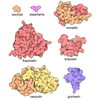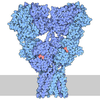+ データを開く
データを開く
- 基本情報
基本情報
| 登録情報 | データベース: PDB / ID: 9omp | ||||||
|---|---|---|---|---|---|---|---|
| タイトル | mGluR7 in native membrane vesicles | ||||||
 要素 要素 | Metabotropic glutamate receptor 7 | ||||||
 キーワード キーワード | MEMBRANE PROTEIN / GPCR / Class C / cluster | ||||||
| 機能・相同性 |  機能・相同性情報 機能・相同性情報group III metabotropic glutamate receptor activity / adenylate cyclase-inhibiting G protein-coupled glutamate receptor signaling pathway / : / negative regulation of glutamate secretion / serine binding / G protein-coupled glutamate receptor signaling pathway / Class C/3 (Metabotropic glutamate/pheromone receptors) / glutamate receptor activity / presynaptic active zone / glutamate binding ...group III metabotropic glutamate receptor activity / adenylate cyclase-inhibiting G protein-coupled glutamate receptor signaling pathway / : / negative regulation of glutamate secretion / serine binding / G protein-coupled glutamate receptor signaling pathway / Class C/3 (Metabotropic glutamate/pheromone receptors) / glutamate receptor activity / presynaptic active zone / glutamate binding / axon development / asymmetric synapse / regulation of synaptic transmission, glutamatergic / adenylate cyclase inhibitor activity / dendritic shaft / PDZ domain binding / sensory perception of sound / adenylate cyclase-inhibiting G protein-coupled receptor signaling pathway / cell cortex / G alpha (i) signalling events / chemical synaptic transmission / postsynaptic membrane / receptor complex / protein dimerization activity / axon / calcium ion binding / dendrite / membrane / plasma membrane 類似検索 - 分子機能 | ||||||
| 生物種 |  Homo sapiens (ヒト) Homo sapiens (ヒト) | ||||||
| 手法 | 電子顕微鏡法 / 単粒子再構成法 / クライオ電子顕微鏡法 / 解像度: 4.3 Å | ||||||
 データ登録者 データ登録者 | Mandala, V. / Fu, Z. / MacKinnon, R. | ||||||
| 資金援助 |  米国, 1件 米国, 1件
| ||||||
 引用 引用 |  ジャーナル: Proc Natl Acad Sci U S A / 年: 2025 ジャーナル: Proc Natl Acad Sci U S A / 年: 2025タイトル: Molecular contacts in self-assembling clusters of membrane proteins. 著者: Venkata Shiva Mandala / Ziao Fu / Roderick MacKinnon /  要旨: Motivated by recent data pointing to the existence of homo-oligomeric assemblies of membrane proteins called higher-order transient structures, and their apparent role in connecting components of ...Motivated by recent data pointing to the existence of homo-oligomeric assemblies of membrane proteins called higher-order transient structures, and their apparent role in connecting components of membrane signal pathways, we examine here by cryoelectron microscopy some of the protein-protein interactions that occur in cluster formation. Metabotropic glutamate receptors and HCN ion channels inside clusters contact their neighbors through structured extracellular and intracellular domains, respectively. Other ion channels, including Kv2.1 and Slo1, appear to form clusters through prominent intrinsically disordered sequences in the cytoplasm. These distinct modes of interaction are associated with clusters exhibiting varying degrees of compactness and order. We conclude that nature utilizes a variety of ways to form connections between membrane proteins in self-assembled clusters. | ||||||
| 履歴 |
|
- 構造の表示
構造の表示
| 構造ビューア | 分子:  Molmil Molmil Jmol/JSmol Jmol/JSmol |
|---|
- ダウンロードとリンク
ダウンロードとリンク
- ダウンロード
ダウンロード
| PDBx/mmCIF形式 |  9omp.cif.gz 9omp.cif.gz | 601.5 KB | 表示 |  PDBx/mmCIF形式 PDBx/mmCIF形式 |
|---|---|---|---|---|
| PDB形式 |  pdb9omp.ent.gz pdb9omp.ent.gz | 414.4 KB | 表示 |  PDB形式 PDB形式 |
| PDBx/mmJSON形式 |  9omp.json.gz 9omp.json.gz | ツリー表示 |  PDBx/mmJSON形式 PDBx/mmJSON形式 | |
| その他 |  その他のダウンロード その他のダウンロード |
-検証レポート
| アーカイブディレクトリ |  https://data.pdbj.org/pub/pdb/validation_reports/om/9omp https://data.pdbj.org/pub/pdb/validation_reports/om/9omp ftp://data.pdbj.org/pub/pdb/validation_reports/om/9omp ftp://data.pdbj.org/pub/pdb/validation_reports/om/9omp | HTTPS FTP |
|---|
-関連構造データ
| 関連構造データ |  70615MC  9omoC M: このデータのモデリングに利用したマップデータ C: 同じ文献を引用 ( |
|---|---|
| 類似構造データ | 類似検索 - 機能・相同性  F&H 検索 F&H 検索 |
- リンク
リンク
- 集合体
集合体
| 登録構造単位 | 
|
|---|---|
| 1 |
|
- 要素
要素
| #1: タンパク質 | 分子量: 102834.938 Da / 分子数: 2 / 由来タイプ: 組換発現 / 由来: (組換発現)  Homo sapiens (ヒト) / 遺伝子: GRM7, GPRC1G, MGLUR7 / 発現宿主: Homo sapiens (ヒト) / 遺伝子: GRM7, GPRC1G, MGLUR7 / 発現宿主:  Homo sapiens (ヒト) / 参照: UniProt: Q14831 Homo sapiens (ヒト) / 参照: UniProt: Q14831Has protein modification | Y | |
|---|
-実験情報
-実験
| 実験 | 手法: 電子顕微鏡法 |
|---|---|
| EM実験 | 試料の集合状態: PARTICLE / 3次元再構成法: 単粒子再構成法 |
- 試料調製
試料調製
| 構成要素 | 名称: mGLuR7 / タイプ: COMPLEX / Entity ID: all / 由来: RECOMBINANT |
|---|---|
| 分子量 | 実験値: NO |
| 由来(天然) | 生物種:  Homo sapiens (ヒト) Homo sapiens (ヒト) |
| 由来(組換発現) | 生物種:  Homo sapiens (ヒト) Homo sapiens (ヒト) |
| 緩衝液 | pH: 7.4 |
| 試料 | 包埋: NO / シャドウイング: NO / 染色: NO / 凍結: YES |
| 急速凍結 | 凍結剤: ETHANE |
- 電子顕微鏡撮影
電子顕微鏡撮影
| 実験機器 |  モデル: Titan Krios / 画像提供: FEI Company |
|---|---|
| 顕微鏡 | モデル: TFS KRIOS |
| 電子銃 | 電子線源:  FIELD EMISSION GUN / 加速電圧: 300 kV / 照射モード: FLOOD BEAM FIELD EMISSION GUN / 加速電圧: 300 kV / 照射モード: FLOOD BEAM |
| 電子レンズ | モード: BRIGHT FIELD / 最大 デフォーカス(公称値): 20000 nm / 最小 デフォーカス(公称値): 10000 nm |
| 撮影 | 電子線照射量: 42 e/Å2 フィルム・検出器のモデル: FEI FALCON IV (4k x 4k) |
- 解析
解析
| CTF補正 | タイプ: PHASE FLIPPING AND AMPLITUDE CORRECTION | ||||||||||||||||||||||||
|---|---|---|---|---|---|---|---|---|---|---|---|---|---|---|---|---|---|---|---|---|---|---|---|---|---|
| 3次元再構成 | 解像度: 4.3 Å / 解像度の算出法: FSC 0.143 CUT-OFF / 粒子像の数: 498211 / 対称性のタイプ: POINT | ||||||||||||||||||||||||
| 精密化 | 交差検証法: NONE 立体化学のターゲット値: GeoStd + Monomer Library + CDL v1.2 | ||||||||||||||||||||||||
| 原子変位パラメータ | Biso mean: 76.99 Å2 | ||||||||||||||||||||||||
| 拘束条件 |
|
 ムービー
ムービー コントローラー
コントローラー






 PDBj
PDBj

